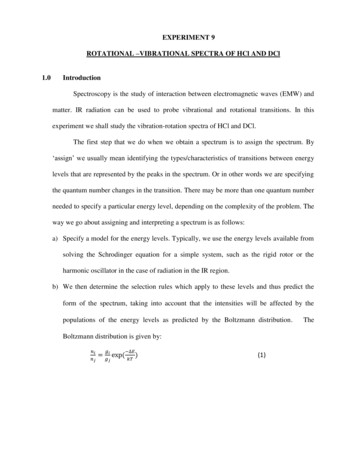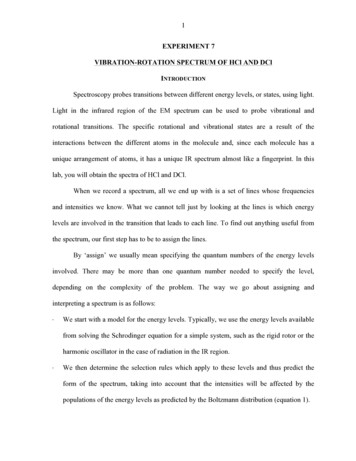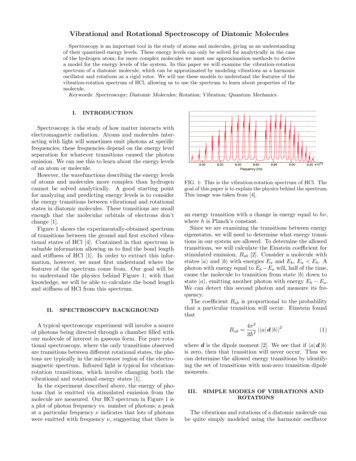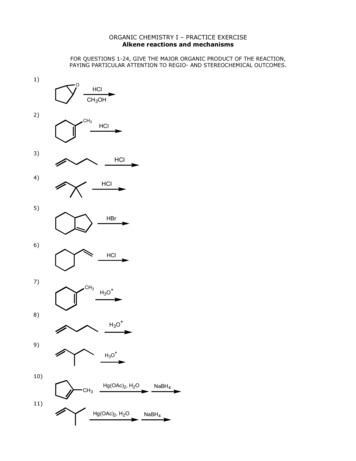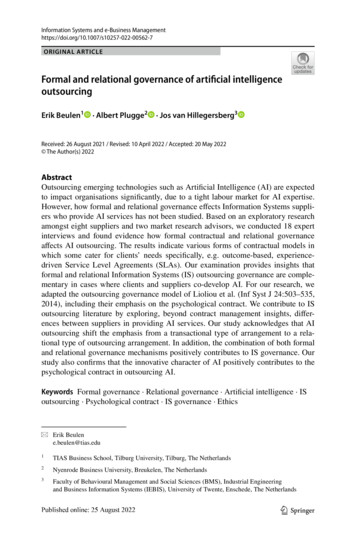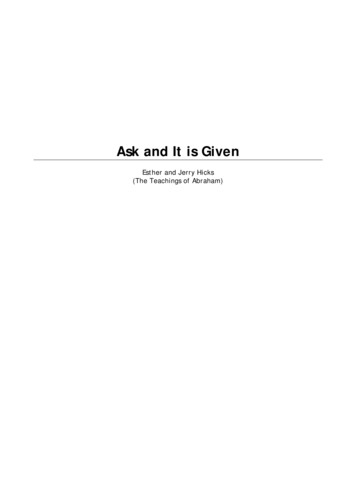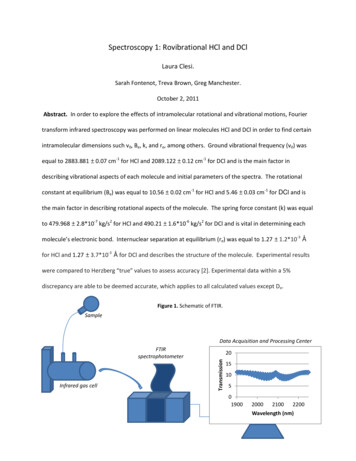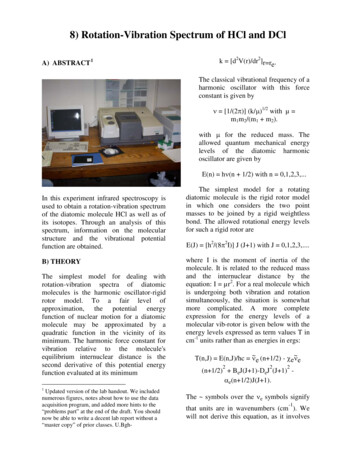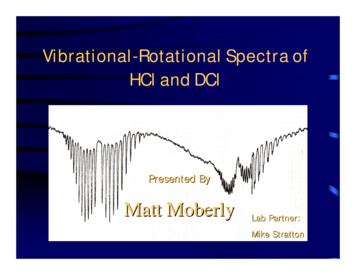
Transcription
Vibrational-Rotational Spectra ofHCl and DClPresented ByMatt MoberlyLab Partner:Mike Stratton
Presentation OutlineI. Introductiona. Purposeb. Theoryc. EquationsII. Experimental MethodIII. Resultsa. Spectrab. Calculations and Error Analysisc. Theoretical CalculationsIV. ConclusionV. References
IntroductionPurpose:Use the infrared vibrational spectrum of HCl andDCl to obtain the following: Moment of Inertia, IeInternuclear Separation, reForce Constant, kEvidence of the Isotope Effect
Theory:Simplest vibrating diatomic model is aharmonic oscillator described by1:E (υ ) hv (υ 12 )Simplest rotating diatomic model is the rigidrotor or “dumb-bell” model which can bepictured as two masses joined by a rigid,weightless rod and described by1:E (J ) h28π I2J ( J 1)
This more complete energy expression contains bothrotational and vibrational parts as well as a finalcoupling portion1E(υ, J ) ve (υ 12 ) v e xe (υ 12 )2 Be J (J 1) De J 2 (J 1)2 αe (υ 12 )J (J 1)hc v Vibrationa l Frequencyex Anharmonic ity ConstanteB Rotational ConstanteD Rotational Constanteα Coupling Constante
Infrared absorption or emission can only occur atallowed transition levels Vibrational: ν” 0, ν’ 1 Rotational: ΔJ 1 R and P branches Spacing between peaksIsotope Effect: mass difference between atomseffects the vibrational and rotational energies Splitting of peaks (35Cl and 37Cl) Compaction of heavier isotope spectrum Shift to higher wavelengths, λ
Equations:Linear Regression Equation2: v Forbidden Frequency(1)v ( x) v 0 (2Be 2αe) x αex 2 4Dex30Rotational Constant3( 2)B eh8π I c2 e(3)hI 8π B ce2eRotational Constant is rearranged solving forthe Moment of Inertia, Ie h, Planks Constant: 6.626076x10-34 J s c, Velocity of light (in vacuum):2.99792485 m s-1Moment of Inertia, Ie1( 4)I μre2 (5)r I NeμAMoment of Inertia is rearranged solving forInternuclear Separation, r μ, reduced mass: mAmB/(mA mB) NA, Avogadro’s Constant
Frequency of Forbidden Transmission1(7)( 6) μv v μ v v 2v x0ee*0ee*1 μ 2v xμ 2e*Frequency equations are used to solve for the two unknownsxe Anharmonic ity ConstantFrequency Equation3(8 ) kN ve 2 π c μ1A 1(9)2k 4π 2c2v e2μNA 1Frequency equation is rearranged solving for the Force Constant, k
Experimental Method
Apparatus Acetone/Dry Ice bath in first trap condense andtrap any D2O/ H2O or D3PO4/ H3PO4 Liquid N2 bath to protect the pump from formedgassesChanges to Apparatus4 Water condenser was not included Three-way valve was placed at position A Manometer was placed between first Acetone/DryIce bath and three-way valve
Preparation of HCl and DCl4Reaction: 2 PCl5 8 D2O 10DCl 2 D3PO4– Since D2O is not pure both HCl and DCl are formed Approx. 2g of PCl5 (green) was placed in flask F– Initial reaction used less than 2 grams PCl5 which did notproduce sufficient amounts of HCl/DCl gas The system was evacuated for approx. 15 minutes 1.0 ml D2O was added to flask F with the I.R. cellopened which produced a violent reactionGas Collection Once reaction was complete, the I.R. cell wasclosed, detached, and placed in the infraredspectrophotometer for analysis
HCl and DCl Spectrum
Calculations and Error Analysis:Equation (1): HClv 0 2779 .23cm 1α e 0 .2954 cm 1Be 10 .558 cm 1De 6 .5422 x10 4 cm 1Herzberg vol. 2v 0 2885 .10 cm 1α e 0 .3019 cm 1Be 10 .591cm 1De NARelative Errorv 3 . 682 %α 2 . 141 %B 0 . 306 %D NA0eeeEquation (1): DClHerzberg vol. 2Relative Errorv 0 2086 .65cm 1α e 0.1064 cm 1Be 5.474 cm 1De 1.57 x10 4 cm 1v 0 2091 .10 cm 1α e 0.1118 cm 1Be 5.445 cm 1De NAv 0 . 198 %α 4 . 847 %B 0 . 537 %D NA0eee
Equation (3): HClI 2.651x10 cm gm 402Equation (3): DClHerzberg vol. 2Relative ErrorI 2.643x10 cm gm 402Herzberg vol. 20.307%Relative ErrorI 5.114x10 cm gmI 5.141x10 cm gm0.534%Equation (5): HClHerzberg vol. 2Relative Errorre 1 .277 x10 8 cmre 1.2746 x10 8 cm0.162%Equation (5): DClHerzberg vol. 2 402re 1 .272 x10 8 cm 402re 1.2749 x10 8 cmRelative Error0.258%
Equation (6&7): Equil.Vibrating Frequency forHCl and anharmonicityc o n s t a n tv e 3239.62cm 1v x 230.198cm 1eexe 0.071Equation (9): HClk 6.057x105 cm 1dyneklit 5.159x105 cm 1dyneΔ 17.414%Theoretical Calculations5:HF Resultsre 1.313x10 8 cmv e 3372.52 cm 1Be 9.977cm 1MP Resultsre 1.280x10 8 cmv e 3049.15 cm 1Be 10.502cm 1
Potential Energy as a Function of Internuclearseparation, re
Potential Curve of HCl using Hartree-Fock(HF) and Moeller-Plessett (MP) TheoriesHCL Potential Cuve-459012345-459.2Energy, r Separation, 10-10m6
Conclusion Largest Source of Error likely from Spectra Readings– Force Constant– Coupling Constant– Reduce systematic error by “zooming” in– Use a new I.R. Cell Internuclear Separation fluctuates with Moment ofInertia, Ie , obtained is an average xe shows anharmonicity of HCl molecule is small Isotope Effect observed for 35Cl and 37Cl
References1 Shoemaker et. al., Expt. In Physical Chemistry, 6th ed. pg. 397.2 Poshusta, R.D HCl Spectrum Analysis, Mathcad 20 Dec. 1997.3 Herzberg, G. Molecular Spectra and Molecular Structure I:Spectra of Diatomic Molecules. 2d ed., chp.III. Van Nostrand,Princeton , N.J. (1950).4 Henscheid, Leonard. Supplement to Expt. 38: RotationVibration Spectrum of HCl and DCl. Chemistry 334 Handout,Washington State University (1998).5 Poshusta, R.D. Expt.38B: Modeling the Spectrum of HCl withAb Initio Quantum Chemistry. Chemistry 334 Handout,Washington State University (1998).
rotational and vibrational parts as well as a final coupling portion. 1. Coupling Constant D Rotational Constant B Rotational Constant x Anharmonic ity Constant v Vibrational Frequency . e e e e e. α
